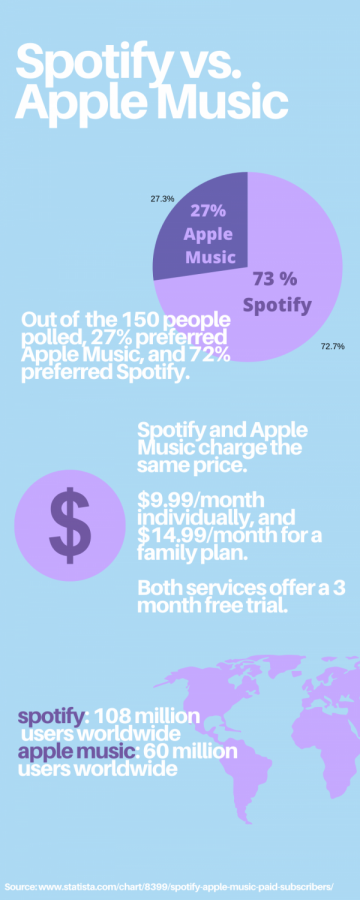Spotify vs. Apple Music: streaming services offer unique music experiences
February 24, 2020
Rap, country, rock, and hip-hop music fill up the playlists of many teens as they find new and old tracks to suit their personal music preferences. To satisfy the diverse taste in music listeners and provide new albums and artists to listen to, music streaming services are constantly evolving and competing to provide the best user experience.
The two companies taking the lead in mobile music streaming are Spotify and Apple Music, each delivering recommendation services, playlist building tools, yearly music recaps and other features.
Spotify, launched in October of 2008, was a major pioneer in the new concept of music streaming. The service was created to battle the rising issue of music piracy in the age of the internet, as many artists struggled to keep their songs off illegal websites. Spotify currently has over 100 million paid users worldwide and is by far the leader of the music streaming market.
“I like the fact that we can choose from over a million songs. We get to not only listen to songs, but also podcasts,” senior Miguel Cid-Rosas, a subscriber to Spotify Premium, said. “We can find any song we want to and we can also listen to albums and latest releases.”
Many music fans enjoy Spotify’s recommendation feature that is “spot-on” to each individual’s music taste, according to senior Lili Phung.
“[Spotify] makes playlists for me and daily mixes that I really like,” Phung said. “They make [playlists] that are called ‘On Repeat’ for me which are songs that I listen to all the time…I really think they have a good algorithm going.”
Another leader in the streaming industry is Apple Music. The service launched more recently in June of 2015. Apple had already changed the way the world listened to music in 2001 with iTunes and the first iPod, and 14 years later, they emerged into the streaming scene with a service that was attractive to iPhone users due to its natural compatibility with the iPhone. Apple Music currently has 60 million paid users worldwide.
“I like to go on Apple Music’s recommended section,” junior Marco Uribe said. “They have playlists for what’s new and stuff they think you would like, and I find a lot of my new music from that.
Streaming services like Spotify and Apple Music are able to collect listening data from subscribers to tailor new playlists that cater to their music tastes. According to Spotify’s privacy policy, they collect data from users “to understand your streaming habits so we can deliver an exceptional and personalized service specifically for you.”
“I love R&B and a lot of alternative stuff,” Phung said. “[Spotify] curates playlists with similar vibes, with something that’s a little bit off the mark, that they think I would like. They throw that into a playlist with songs I already love… so it kind of keeps me listening.”
Spotify and Apple Music’s curated playlists are updated daily, offering mixes of new music and collections of songs within genres. These playlists spotlight songs that may have gone undiscovered, as well as give music artists a platform to reach new audiences.
Music streaming allows listeners to not only listen and discover music, but share it with their friends and followers. Posting albums, artists and songs to social media, specifically Instagram stories, has become a popular form of expression that allows people to showcase their music tastes.
“I think someone’s taste in music says a lot about them, and to see that is fun,” Phung said.






![GETTING BETTER TOGETHER Mater Dei swimmers exert themselves at morning practice. As the season approaches, the swim team must discipline themselves for their early swim competitions. “Waking up early for practice is really hard, and getting yourself up in the morning and committing to the sport can be [difficult] at times,” Acevedo said.](https://thescarletscroll.com/wp-content/uploads/2025/10/img_9894-1200x800.jpg)

![FRIENDSHIP IN PRINT Members of the Hi-Lighter student newspaper gather for a press conference in 1954. Among them is senior Lenore Rigney (O’Hara), who had worked on the publication for two years after transferring to Mater Dei as a junior. “I found the students were all so friendly and accepting,” O’Hara said. “It was [important] to be friendly to someone new and to help them get used to the school and make friends.”](https://thescarletscroll.com/wp-content/uploads/2025/10/IMG_3582-1200x794.jpeg)
